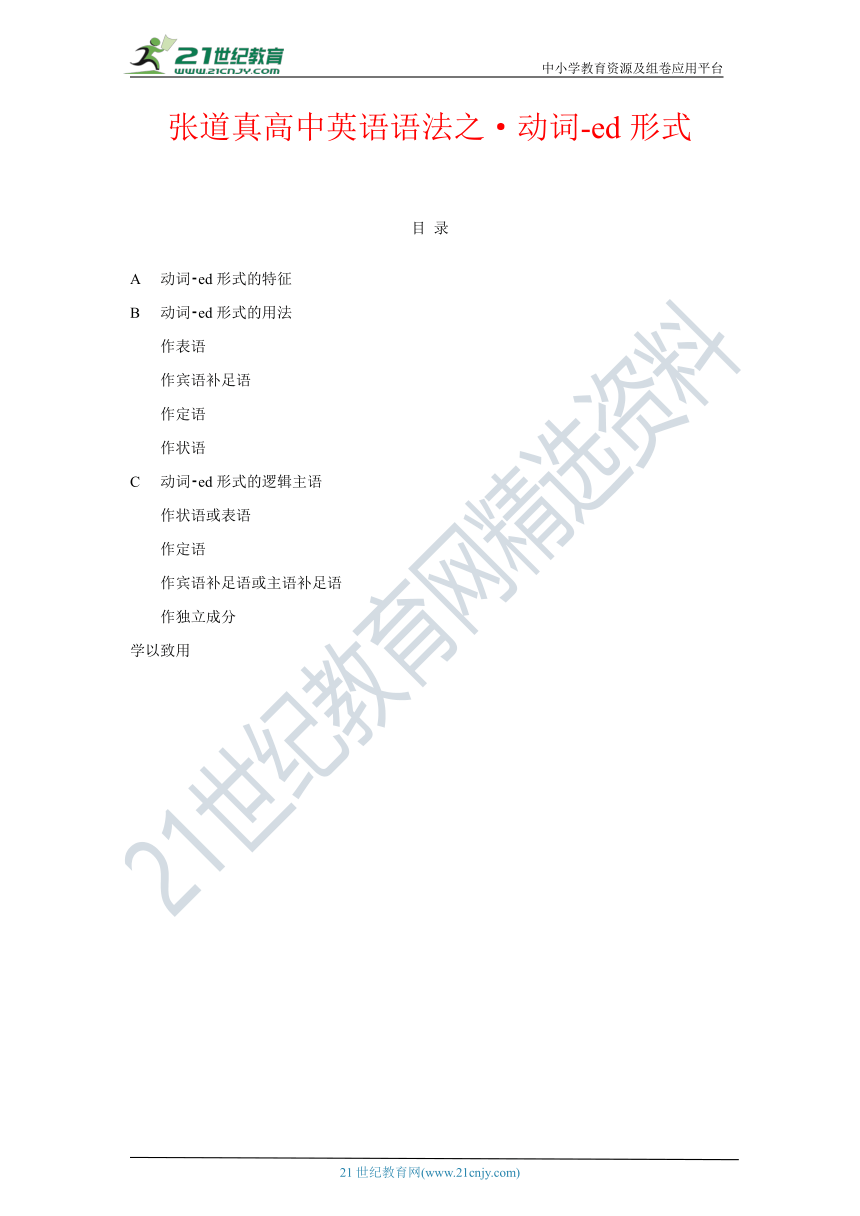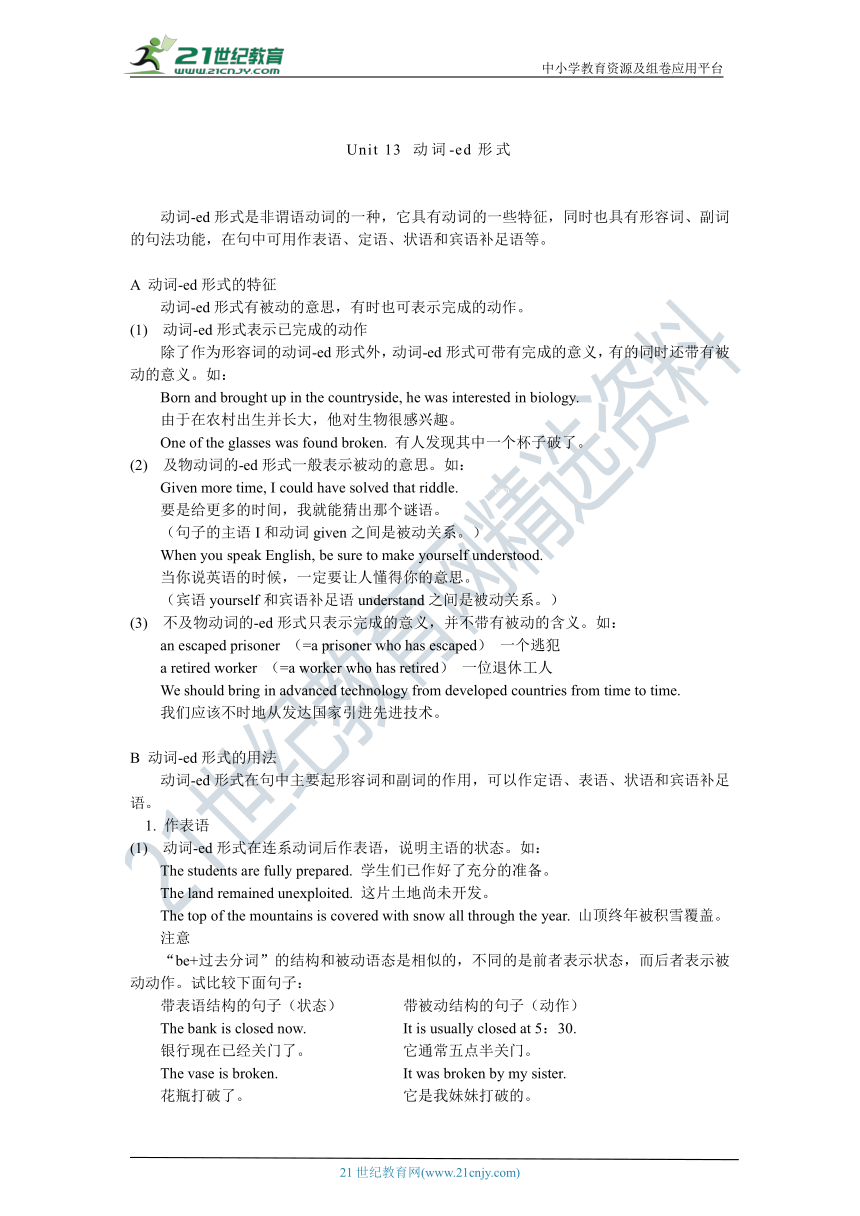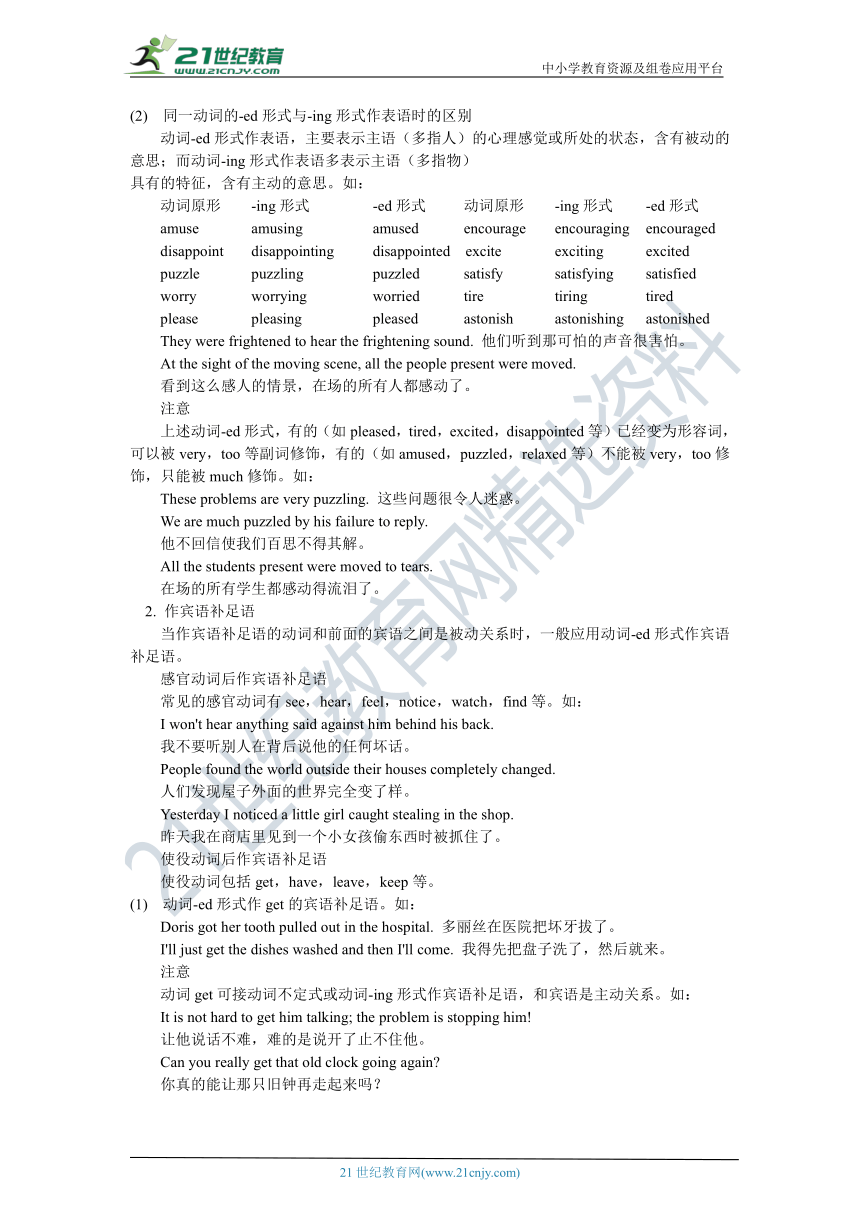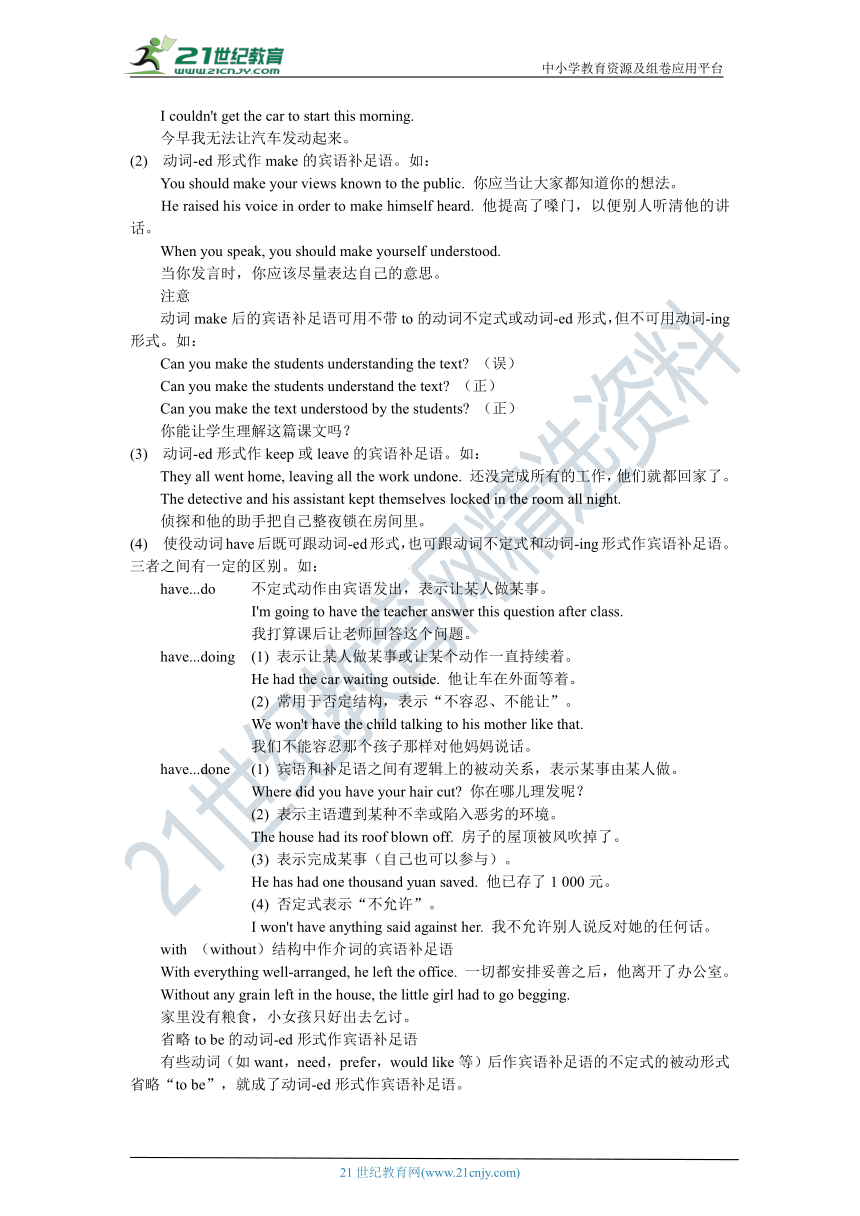高中英语语法之13动词-ed形式
图片预览




文档简介
中小学教育资源及组卷应用平台
张道真高中英语语法之·动词-ed形式
目 录
A 动词 ed形式的特征
B 动词 ed形式的用法
作表语
作宾语补足语
作定语
作状语
C 动词 ed形式的逻辑主语
作状语或表语
作定语
作宾语补足语或主语补足语
作独立成分
学以致用
Unit 13 动词-ed形式
动词-ed形式是非谓语动词的一种,它具有动词的一些特征,同时也具有形容词、副词的句法功能,在句中可用作表语、定语、状语和宾语补足语等。21cnjy.com
A 动词-ed形式的特征
动词-ed形式有被动的意思,有时也可表示完成的动作。
(1) 动词-ed形式表示已完成的动作
除了作为形容词的动词-ed形式外,动词-ed形式可带有完成的意义,有的同时还带有被动的意义。如:21·cn·jy·com
Born and b_rought_ up in the countryside, he was interested in biology.
由于在农村出生并长大,他对生物很感兴趣。
One of the glasses was found broken. 有人发现其中一个杯子破了。
(2) 及物动词的-ed形式一般表示被动的意思。如:
Given more time, I could have solved that riddle. 21*cnjy*com
要是给更多的时间,我就能猜出那个谜语。
(句子的主语I和动词given之间是被动关系。)
When you speak English, be sure to make yourself understood.
当你说英语的时候,一定要让人懂得你的意思。
(宾语yourself和宾语补足语understand之间是被动关系。)
(3) 不及物动词的-ed形式只表示完成的意义,并不带有被动的含义。如:
an escaped prisoner (=a prisoner who has escaped) 一个逃犯
a retired worker (=a worker who has retired) 一位退休工人
We should brin_g_in_a_dvanced technology from developed countries from time to time.
我们应该不时地从发达国家引进先进技术。
B 动词-ed形式的用法
动词-ed形式在句中主要起形容词和副词的作用,可以作定语、表语、状语和宾语补足语。
1. 作表语
(1) 动词-ed形式在连系动词后作表语,说明主语的状态。如:
The students are fully prepared. 学生们已作好了充分的准备。
The land remained unexploited. 这片土地尚未开发。
The top _of_the_ mountains is covered with snow all through the year. 山顶终年被积雪覆盖。
注意
“be+过去分词”的结构和被动语态是相似的,不同的是前者表示状态,而后者表示被动动作。试比较下面句子:21*cnjy*com
带表语结构的句子(状态) 带被动结构的句子(动作)
The bank is closed now. It is usually closed at 5:30.
银行现在已经关门了。 它通常五点半关门。
The vase is broken. It was broken by my sister.
花瓶打破了。 它是我妹妹打破的。
(2) 同一动词的-ed形式与-ing形式作表语时的区别
动词-ed形式作表语,主要表示主语(多指人)的心理感觉或所处的状态,含有被动的意思;而动词-ing形式作表语多表示主语(多指物)
具有的特征,含有主动的意思。如:
动词原形 -ing形式 -ed形式 动词原形 -ing形式 -ed形式
amuse amusing amused encourage encouraging encouraged
disappoint disappointing disappointed excite exciting excited
puzzle puzzling puzzled satisfy satisfying satisfied
worry worrying worried tire tiring tired
please pleasing pleased astonish astonishing astonished
They were frightened to hear the frightening sound. 他们听到那可怕的声音很害怕。
At the sight of the moving scene, all the people present were moved.
看到这么感人的情景,在场的所有人都感动了。
注意
上述动词-ed形式,有的_ plea_sed,tired,excited,disappointed等)已经变为形容词,可以被very,too等副词修饰,有的(如amused,puzzled,relaxed等)不能被very,too修饰,只能被much修饰。如:
These problems are very puzzling. 这些问题很令人迷惑。
We are much puzzled by his failure to reply.
他不回信使我们百思不得其解。
All the students present were moved to tears.
在场的所有学生都感动得流泪了。
2. 作宾语补足语
当作宾语补足语的动词和前面的宾语之间是被动关系时,一般应用动词-ed形式作宾语补足语。
感官动词后作宾语补足语
常见的感官动词有see,hear,feel,notice,watch,find等。如:
I won't hear anything said against him behind his back.
我不要听别人在背后说他的任何坏话。
People found the world outside their houses completely changed.
人们发现屋子外面的世界完全变了样。
Yesterday I noticed a little girl caught stealing in the shop.
昨天我在商店里见到一个小女孩偷东西时被抓住了。
使役动词后作宾语补足语
使役动词包括get,have,leave,keep等。
(1) 动词-ed形式作get的宾语补足语。如:
Doris got her tooth pulled out in the hospital. 多丽丝在医院把坏牙拔了。
I'll just get the dishes washed and then I'll come. 我得先把盘子洗了,然后就来。
注意
动词get可接动词不定式或动词-ing形式作宾语补足语,和宾语是主动关系。如:
It is not hard to get him talking; the problem is stopping him!
让他说话不难,难的是说开了止不住他。
Can you really get that old clock going again
你真的能让那只旧钟再走起来吗?
I couldn't get the car to start this morning.
今早我无法让汽车发动起来。
(2) 动词-ed形式作make的宾语补足语。如:
You should make your views known to the public. 你应当让大家都知道你的想法。
He rais_ed_his_ voice in order to make himself heard. 他提高了嗓门,以便别人听清他的讲话。
When you speak, you should make yourself understood.
当你发言时,你应该尽量表达自己的意思。
注意
动词make后的宾语补足语可用不带to的动词不定式或动词-ed形式,但不可用动词-ing形式。如:
Can you make the students understanding the text (误)
Can you make the students understand the text (正)
Can you make the text understood by the students (正)
你能让学生理解这篇课文吗?
(3) 动词-ed形式作keep或leave的宾语补足语。如:
They all went home, leaving all the work undone. 还没完成所有的工作,他们就都回家了。
The detectiv_e_and__his assistant kept themselves locked in the room all night.
侦探和他的助手把自己整夜锁在房间里。
(4) 使役动词have后既可跟动词-ed形式,也可跟动词不定式和动词-ing形式作宾语补足语。三者之间有一定的区别。如:【版权所有:21教育】
have...do 不定式动作由宾语发出,表示让某人做某事。
I'm going to have the teacher answer this question after class.
我打算课后让老师回答这个问题。
have...doing (1) 表示让某人做某事或让某个动作一直持续着。
He had the car waiting outside. 他让车在外面等着。
(2) 常用于否定结构,表示“不容忍、不能让”。
We won't have the child talking to his mother like that.
我们不能容忍那个孩子那样对他妈妈说话。
have...done (1) 宾语和补足语之间有逻辑上的被动关系,表示某事由某人做。
Where did you have your hair cut 你在哪儿理发呢?
(2) 表示主语遭到某种不幸或陷入恶劣的环境。
The house had its roof blown off. 房子的屋顶被风吹掉了。
(3) 表示完成某事(自己也可以参与)。
He has had one thousand yuan saved. 他已存了1 000元。
(4) 否定式表示“不允许”。
I won't have anything said against her. 我不允许别人说反对她的任何话。
with (without)结构中作介词的宾语补足语
With everythi_ng_wel_l-arranged, he left the office. 一切都安排妥善之后,他离开了办公室。
Without any gra_in_lef_t in the house, the little girl had to go begging.
家里没有粮食,小女孩只好出去乞讨。
省略to be的动词-ed形式作宾语补足语
有些动词(如w_ant ne_ed,prefer,would like等)后作宾语补足语的不定式的被动形式省略“to be”,就成了动词-ed形式作宾语补足语。
如:
The peasant don't want good farmland (to be) built on.
农民们不想让好的农田被用来盖房子。
We need the work (to be) finished by Saturday. 我们需要这项工作在星期六之前完成。
3. 作定语
动词-ed形式作定语修饰名词分为前置和后置两类。
(1) 作前置定语
单个动词-ed形式作定语一般放在被修饰的名词之前,作前置定语。如:
cooked food 熟食 revised edition 修订本
highly developed industry 高度发展的工业
A watched pot never boils. 心急锅不开。
注意
如要表示强调,单个动词-ed形式也可作后置定语。如:
Money spent is more than money earned. 入不敷出。
(2) 作后置定语
作后置定语的动词-ed形式一般都带有修饰语或其他成分,在语法上相当于一个定语从句。如:
The system used (=which is used) in this school is very successful. 21·世纪*教育网
这所学校使用的系统很成功。
Some o_f_the__people invited (=who have been invited) to the party can't come.
有些被邀请参加晚会的人不能来。
The police nev_er_fou_nd the money stolen (= which was stolen) in the robbery.
在劫案中被抢去的钱警察始终未找到。
(3) 动词-ed形式与动词-ing形式作定语的比较
动词-ed形式作定语表示被动或动作已完成,而动词-ing形式作定语表示主动或动作正在进行。如:
the risen sun 升起了的太阳 the rising sun 正在升起的太阳 boiled water 开水
boiling water 正沸腾的水 fallen leaves 落叶falling leaves 正在飘落的叶子
4. 作状语
动词-ed形式作状语和动词-ing形式作状语一样,也可表示时间、原因、条件、让步、方式或伴随情况等。【出处:21教育名师】
(1) 表示时间
动词-ed形式作状语表示时间,相当于一个时间状语从句。如:
Seen from the__tower_, the city looks beautiful. (=When the city is seen from the tower...)
从塔上往下看,城市看起来很美。
Shown the__lab,__we were taken to see the library. (=After we had been shown the lab...)
我们参观了实验室之后,又参观了图书馆。
Viewed from a distance, the island looked like a cloud. 21世纪教育网版权所有
(=When they were viewed from a distance...) 从远处看,这座岛屿就像一朵云。
注意
有时动词-ed形式前可加连词when,while等来强调时间概念。如:
Once recovered, he went all to do his work.
一恢复健康,他就全力以赴地干起了工作。
When a_sked_w_hy she was late for class again, she hung her head in shame.
当被问到为什么上课又迟到时,她羞愧地低下了头。
(2) 表示原因
动词-ed形式作状语表示原因,相当于一个原因状语从句。如:
Moved by the heroic deeds, the children couldn't help crying. 21教育网
(=Since they were moved by the heroic deeds...)
孩子们被英雄事迹所感动,情不自禁地哭了起来。
Born into a peasant family, he had only two years of schooling. 2-1-c-n-j-y
(=As he was born into a peasant family...) 他出生在农民家庭,只上过两年学。
(3) 表示条件
动词-ed形式表示条件,相当于一个条件状语从句。如:
Heated, wa_ter_ch_anges into steam. (=If water is heated...) 水加热就变成水蒸气。
Compared with other professors, she was an excellent speaker. 21教育名师原创作品
(=If she was compared with other professors...)
与其他教授相比,她是一位优秀的演说家。
(4) 表示让步
动词-ed形式作状语表示让步,相当于一个though / although引导的让步状语从句。如:
Exhausted by the running, they went on running after the robber.
(=Although they were exhausted by the running...)
尽管已经跑的筋疲力尽,他们还是继续追赶着那个强盗。
Questioned many times a day, Andrew kept silent over the matter.
(=Although Andrew was questioned many times a day...)
尽管一天被盘问了多次,安德鲁仍然对那件事保持沉默。
注意
有时动词-ed形式作状语和动词-ing形式被动式作状语,并没有多大的区别,可以互换使用。如:
Suddenly seized with a high fever, he was unable to attend school.
(=Being sudd_enly_s_eized with a high fever, he was unable to attend school.)
他因突然发高烧而不能来上学。
Brought _up_in__the countryside, he found it hard to get used to town life.
(=Having been br_ought__up in the countryside, he found it hard to get used to town life.)
因为是在农村长大的,他发现很难适应城镇生活。
(5) 表示行为方式、伴随情况或补充说明
动词-ed形式作状语表示行为方式、伴随情况或补充说明时,通常位于句子的后面,相当于一个并列分句。如:
The teac_her_st_ood there, surrounded (=and he was surrounded) by the students.
老师站在那儿,被学生们围住了。
They turne_d_arou_nd and stood in the middle of the room, completely astonished
(=and they were completely astonished). 他们转过身来,站在房间中央,完全惊呆了。
注意
动词-ing形_ è _逻辑主语必须与句子主语一致。如果是主动关系,使用动词-ing形式;如果是被动关系,则使用动词-ed形式;另外,动词-ed形式作状语可表示一种状态。如:
Don't sit there doing e and help me with this table.
不要坐在那里无所事事,过来帮我收拾桌子。
Embarrassed, I jump up and go into the house for another cup.
我感到很尴尬,跳了起来,走进屋里,又喝了一杯茶。
C 动词-ed形式的逻辑主语
1. 作状语或表语
动词-ed形式在句中作状语或表语时,它的逻辑主语通常就是句子的主语,动词-ed形式和主语之间是被动关系。如:
Locked up, he had no way to escape. 由于被锁了起来,他没有办法逃跑了。
Lost in thought, he almost ran into the car in front of him.
由于陷入了沉思,他差点儿撞到了前面的汽车上。
Though it was 10:00 a.m., the door of the shop remained locked.
尽管是上午10点了,商店的门仍然锁着。
2. 作定语
当动词-ed形式在句中作定语时,它的逻辑主语是被它修饰的名词,它和该名词之间是被动关系。如:
The excited children are opening their Christmas presents.
激动的孩子们正在打开他们的圣诞礼物。
Interested members will meet at two o'clock. 感兴趣的会员两点钟见面。
A lighted candle lit up the cellar. 一支点燃的蜡烛照亮了地下室。
3. 作宾语补足语或主语补足语
当动词-ed形式在句中作宾语补足语或主语补足语时,它的逻辑主语是句子的宾语或主语,它们之间是被动的关系。如:
The valuable vase was found stolen. 那个珍贵的花瓶被盗了。
(stolen的逻辑主语是句子的主语vase。)
We got home only to find the whole house turned upside down.
Thieves obvious-ly had broken in.
我们回到家发现整个房子被翻得乱七八糟,很明显小偷闯进来了。
(turned upside down的逻辑主语是句子的宾语house。)
注意
动词-ed形式有时可有其独立的逻辑主语,常用作状语。如:
All things considered, the planed trip will have to be called off.www.21-cn-jy.com
考虑到所有的情况,原来计划好的旅行不得不取消。
All the money run out, Henry had to find another job. 【来源:21·世纪·教育·网】
所有的钱用完了,亨利不得不再找一份工作。
4. 作独立成分
动词-ed形式的一些固定词组也可在句中作独立成分,不受逻辑主语的限制。如:
Put frankly, I don't agree with what he said. 坦白地说,我不同意他所说的。
Given the g_eneral_ state of his health, it may take him a while to recover from the operation.
考虑到他平时的身体状况,手术后的恢复可能需要一段时间。
_21 è (www.21cnjy.com)_
张道真高中英语语法之·动词-ed形式
目 录
A 动词 ed形式的特征
B 动词 ed形式的用法
作表语
作宾语补足语
作定语
作状语
C 动词 ed形式的逻辑主语
作状语或表语
作定语
作宾语补足语或主语补足语
作独立成分
学以致用
Unit 13 动词-ed形式
动词-ed形式是非谓语动词的一种,它具有动词的一些特征,同时也具有形容词、副词的句法功能,在句中可用作表语、定语、状语和宾语补足语等。21cnjy.com
A 动词-ed形式的特征
动词-ed形式有被动的意思,有时也可表示完成的动作。
(1) 动词-ed形式表示已完成的动作
除了作为形容词的动词-ed形式外,动词-ed形式可带有完成的意义,有的同时还带有被动的意义。如:21·cn·jy·com
Born and b_rought_ up in the countryside, he was interested in biology.
由于在农村出生并长大,他对生物很感兴趣。
One of the glasses was found broken. 有人发现其中一个杯子破了。
(2) 及物动词的-ed形式一般表示被动的意思。如:
Given more time, I could have solved that riddle. 21*cnjy*com
要是给更多的时间,我就能猜出那个谜语。
(句子的主语I和动词given之间是被动关系。)
When you speak English, be sure to make yourself understood.
当你说英语的时候,一定要让人懂得你的意思。
(宾语yourself和宾语补足语understand之间是被动关系。)
(3) 不及物动词的-ed形式只表示完成的意义,并不带有被动的含义。如:
an escaped prisoner (=a prisoner who has escaped) 一个逃犯
a retired worker (=a worker who has retired) 一位退休工人
We should brin_g_in_a_dvanced technology from developed countries from time to time.
我们应该不时地从发达国家引进先进技术。
B 动词-ed形式的用法
动词-ed形式在句中主要起形容词和副词的作用,可以作定语、表语、状语和宾语补足语。
1. 作表语
(1) 动词-ed形式在连系动词后作表语,说明主语的状态。如:
The students are fully prepared. 学生们已作好了充分的准备。
The land remained unexploited. 这片土地尚未开发。
The top _of_the_ mountains is covered with snow all through the year. 山顶终年被积雪覆盖。
注意
“be+过去分词”的结构和被动语态是相似的,不同的是前者表示状态,而后者表示被动动作。试比较下面句子:21*cnjy*com
带表语结构的句子(状态) 带被动结构的句子(动作)
The bank is closed now. It is usually closed at 5:30.
银行现在已经关门了。 它通常五点半关门。
The vase is broken. It was broken by my sister.
花瓶打破了。 它是我妹妹打破的。
(2) 同一动词的-ed形式与-ing形式作表语时的区别
动词-ed形式作表语,主要表示主语(多指人)的心理感觉或所处的状态,含有被动的意思;而动词-ing形式作表语多表示主语(多指物)
具有的特征,含有主动的意思。如:
动词原形 -ing形式 -ed形式 动词原形 -ing形式 -ed形式
amuse amusing amused encourage encouraging encouraged
disappoint disappointing disappointed excite exciting excited
puzzle puzzling puzzled satisfy satisfying satisfied
worry worrying worried tire tiring tired
please pleasing pleased astonish astonishing astonished
They were frightened to hear the frightening sound. 他们听到那可怕的声音很害怕。
At the sight of the moving scene, all the people present were moved.
看到这么感人的情景,在场的所有人都感动了。
注意
上述动词-ed形式,有的_ plea_sed,tired,excited,disappointed等)已经变为形容词,可以被very,too等副词修饰,有的(如amused,puzzled,relaxed等)不能被very,too修饰,只能被much修饰。如:
These problems are very puzzling. 这些问题很令人迷惑。
We are much puzzled by his failure to reply.
他不回信使我们百思不得其解。
All the students present were moved to tears.
在场的所有学生都感动得流泪了。
2. 作宾语补足语
当作宾语补足语的动词和前面的宾语之间是被动关系时,一般应用动词-ed形式作宾语补足语。
感官动词后作宾语补足语
常见的感官动词有see,hear,feel,notice,watch,find等。如:
I won't hear anything said against him behind his back.
我不要听别人在背后说他的任何坏话。
People found the world outside their houses completely changed.
人们发现屋子外面的世界完全变了样。
Yesterday I noticed a little girl caught stealing in the shop.
昨天我在商店里见到一个小女孩偷东西时被抓住了。
使役动词后作宾语补足语
使役动词包括get,have,leave,keep等。
(1) 动词-ed形式作get的宾语补足语。如:
Doris got her tooth pulled out in the hospital. 多丽丝在医院把坏牙拔了。
I'll just get the dishes washed and then I'll come. 我得先把盘子洗了,然后就来。
注意
动词get可接动词不定式或动词-ing形式作宾语补足语,和宾语是主动关系。如:
It is not hard to get him talking; the problem is stopping him!
让他说话不难,难的是说开了止不住他。
Can you really get that old clock going again
你真的能让那只旧钟再走起来吗?
I couldn't get the car to start this morning.
今早我无法让汽车发动起来。
(2) 动词-ed形式作make的宾语补足语。如:
You should make your views known to the public. 你应当让大家都知道你的想法。
He rais_ed_his_ voice in order to make himself heard. 他提高了嗓门,以便别人听清他的讲话。
When you speak, you should make yourself understood.
当你发言时,你应该尽量表达自己的意思。
注意
动词make后的宾语补足语可用不带to的动词不定式或动词-ed形式,但不可用动词-ing形式。如:
Can you make the students understanding the text (误)
Can you make the students understand the text (正)
Can you make the text understood by the students (正)
你能让学生理解这篇课文吗?
(3) 动词-ed形式作keep或leave的宾语补足语。如:
They all went home, leaving all the work undone. 还没完成所有的工作,他们就都回家了。
The detectiv_e_and__his assistant kept themselves locked in the room all night.
侦探和他的助手把自己整夜锁在房间里。
(4) 使役动词have后既可跟动词-ed形式,也可跟动词不定式和动词-ing形式作宾语补足语。三者之间有一定的区别。如:【版权所有:21教育】
have...do 不定式动作由宾语发出,表示让某人做某事。
I'm going to have the teacher answer this question after class.
我打算课后让老师回答这个问题。
have...doing (1) 表示让某人做某事或让某个动作一直持续着。
He had the car waiting outside. 他让车在外面等着。
(2) 常用于否定结构,表示“不容忍、不能让”。
We won't have the child talking to his mother like that.
我们不能容忍那个孩子那样对他妈妈说话。
have...done (1) 宾语和补足语之间有逻辑上的被动关系,表示某事由某人做。
Where did you have your hair cut 你在哪儿理发呢?
(2) 表示主语遭到某种不幸或陷入恶劣的环境。
The house had its roof blown off. 房子的屋顶被风吹掉了。
(3) 表示完成某事(自己也可以参与)。
He has had one thousand yuan saved. 他已存了1 000元。
(4) 否定式表示“不允许”。
I won't have anything said against her. 我不允许别人说反对她的任何话。
with (without)结构中作介词的宾语补足语
With everythi_ng_wel_l-arranged, he left the office. 一切都安排妥善之后,他离开了办公室。
Without any gra_in_lef_t in the house, the little girl had to go begging.
家里没有粮食,小女孩只好出去乞讨。
省略to be的动词-ed形式作宾语补足语
有些动词(如w_ant ne_ed,prefer,would like等)后作宾语补足语的不定式的被动形式省略“to be”,就成了动词-ed形式作宾语补足语。
如:
The peasant don't want good farmland (to be) built on.
农民们不想让好的农田被用来盖房子。
We need the work (to be) finished by Saturday. 我们需要这项工作在星期六之前完成。
3. 作定语
动词-ed形式作定语修饰名词分为前置和后置两类。
(1) 作前置定语
单个动词-ed形式作定语一般放在被修饰的名词之前,作前置定语。如:
cooked food 熟食 revised edition 修订本
highly developed industry 高度发展的工业
A watched pot never boils. 心急锅不开。
注意
如要表示强调,单个动词-ed形式也可作后置定语。如:
Money spent is more than money earned. 入不敷出。
(2) 作后置定语
作后置定语的动词-ed形式一般都带有修饰语或其他成分,在语法上相当于一个定语从句。如:
The system used (=which is used) in this school is very successful. 21·世纪*教育网
这所学校使用的系统很成功。
Some o_f_the__people invited (=who have been invited) to the party can't come.
有些被邀请参加晚会的人不能来。
The police nev_er_fou_nd the money stolen (= which was stolen) in the robbery.
在劫案中被抢去的钱警察始终未找到。
(3) 动词-ed形式与动词-ing形式作定语的比较
动词-ed形式作定语表示被动或动作已完成,而动词-ing形式作定语表示主动或动作正在进行。如:
the risen sun 升起了的太阳 the rising sun 正在升起的太阳 boiled water 开水
boiling water 正沸腾的水 fallen leaves 落叶falling leaves 正在飘落的叶子
4. 作状语
动词-ed形式作状语和动词-ing形式作状语一样,也可表示时间、原因、条件、让步、方式或伴随情况等。【出处:21教育名师】
(1) 表示时间
动词-ed形式作状语表示时间,相当于一个时间状语从句。如:
Seen from the__tower_, the city looks beautiful. (=When the city is seen from the tower...)
从塔上往下看,城市看起来很美。
Shown the__lab,__we were taken to see the library. (=After we had been shown the lab...)
我们参观了实验室之后,又参观了图书馆。
Viewed from a distance, the island looked like a cloud. 21世纪教育网版权所有
(=When they were viewed from a distance...) 从远处看,这座岛屿就像一朵云。
注意
有时动词-ed形式前可加连词when,while等来强调时间概念。如:
Once recovered, he went all to do his work.
一恢复健康,他就全力以赴地干起了工作。
When a_sked_w_hy she was late for class again, she hung her head in shame.
当被问到为什么上课又迟到时,她羞愧地低下了头。
(2) 表示原因
动词-ed形式作状语表示原因,相当于一个原因状语从句。如:
Moved by the heroic deeds, the children couldn't help crying. 21教育网
(=Since they were moved by the heroic deeds...)
孩子们被英雄事迹所感动,情不自禁地哭了起来。
Born into a peasant family, he had only two years of schooling. 2-1-c-n-j-y
(=As he was born into a peasant family...) 他出生在农民家庭,只上过两年学。
(3) 表示条件
动词-ed形式表示条件,相当于一个条件状语从句。如:
Heated, wa_ter_ch_anges into steam. (=If water is heated...) 水加热就变成水蒸气。
Compared with other professors, she was an excellent speaker. 21教育名师原创作品
(=If she was compared with other professors...)
与其他教授相比,她是一位优秀的演说家。
(4) 表示让步
动词-ed形式作状语表示让步,相当于一个though / although引导的让步状语从句。如:
Exhausted by the running, they went on running after the robber.
(=Although they were exhausted by the running...)
尽管已经跑的筋疲力尽,他们还是继续追赶着那个强盗。
Questioned many times a day, Andrew kept silent over the matter.
(=Although Andrew was questioned many times a day...)
尽管一天被盘问了多次,安德鲁仍然对那件事保持沉默。
注意
有时动词-ed形式作状语和动词-ing形式被动式作状语,并没有多大的区别,可以互换使用。如:
Suddenly seized with a high fever, he was unable to attend school.
(=Being sudd_enly_s_eized with a high fever, he was unable to attend school.)
他因突然发高烧而不能来上学。
Brought _up_in__the countryside, he found it hard to get used to town life.
(=Having been br_ought__up in the countryside, he found it hard to get used to town life.)
因为是在农村长大的,他发现很难适应城镇生活。
(5) 表示行为方式、伴随情况或补充说明
动词-ed形式作状语表示行为方式、伴随情况或补充说明时,通常位于句子的后面,相当于一个并列分句。如:
The teac_her_st_ood there, surrounded (=and he was surrounded) by the students.
老师站在那儿,被学生们围住了。
They turne_d_arou_nd and stood in the middle of the room, completely astonished
(=and they were completely astonished). 他们转过身来,站在房间中央,完全惊呆了。
注意
动词-ing形_ è _逻辑主语必须与句子主语一致。如果是主动关系,使用动词-ing形式;如果是被动关系,则使用动词-ed形式;另外,动词-ed形式作状语可表示一种状态。如:
Don't sit there doing e and help me with this table.
不要坐在那里无所事事,过来帮我收拾桌子。
Embarrassed, I jump up and go into the house for another cup.
我感到很尴尬,跳了起来,走进屋里,又喝了一杯茶。
C 动词-ed形式的逻辑主语
1. 作状语或表语
动词-ed形式在句中作状语或表语时,它的逻辑主语通常就是句子的主语,动词-ed形式和主语之间是被动关系。如:
Locked up, he had no way to escape. 由于被锁了起来,他没有办法逃跑了。
Lost in thought, he almost ran into the car in front of him.
由于陷入了沉思,他差点儿撞到了前面的汽车上。
Though it was 10:00 a.m., the door of the shop remained locked.
尽管是上午10点了,商店的门仍然锁着。
2. 作定语
当动词-ed形式在句中作定语时,它的逻辑主语是被它修饰的名词,它和该名词之间是被动关系。如:
The excited children are opening their Christmas presents.
激动的孩子们正在打开他们的圣诞礼物。
Interested members will meet at two o'clock. 感兴趣的会员两点钟见面。
A lighted candle lit up the cellar. 一支点燃的蜡烛照亮了地下室。
3. 作宾语补足语或主语补足语
当动词-ed形式在句中作宾语补足语或主语补足语时,它的逻辑主语是句子的宾语或主语,它们之间是被动的关系。如:
The valuable vase was found stolen. 那个珍贵的花瓶被盗了。
(stolen的逻辑主语是句子的主语vase。)
We got home only to find the whole house turned upside down.
Thieves obvious-ly had broken in.
我们回到家发现整个房子被翻得乱七八糟,很明显小偷闯进来了。
(turned upside down的逻辑主语是句子的宾语house。)
注意
动词-ed形式有时可有其独立的逻辑主语,常用作状语。如:
All things considered, the planed trip will have to be called off.www.21-cn-jy.com
考虑到所有的情况,原来计划好的旅行不得不取消。
All the money run out, Henry had to find another job. 【来源:21·世纪·教育·网】
所有的钱用完了,亨利不得不再找一份工作。
4. 作独立成分
动词-ed形式的一些固定词组也可在句中作独立成分,不受逻辑主语的限制。如:
Put frankly, I don't agree with what he said. 坦白地说,我不同意他所说的。
Given the g_eneral_ state of his health, it may take him a while to recover from the operation.
考虑到他平时的身体状况,手术后的恢复可能需要一段时间。
_21 è (www.21cnjy.com)_
